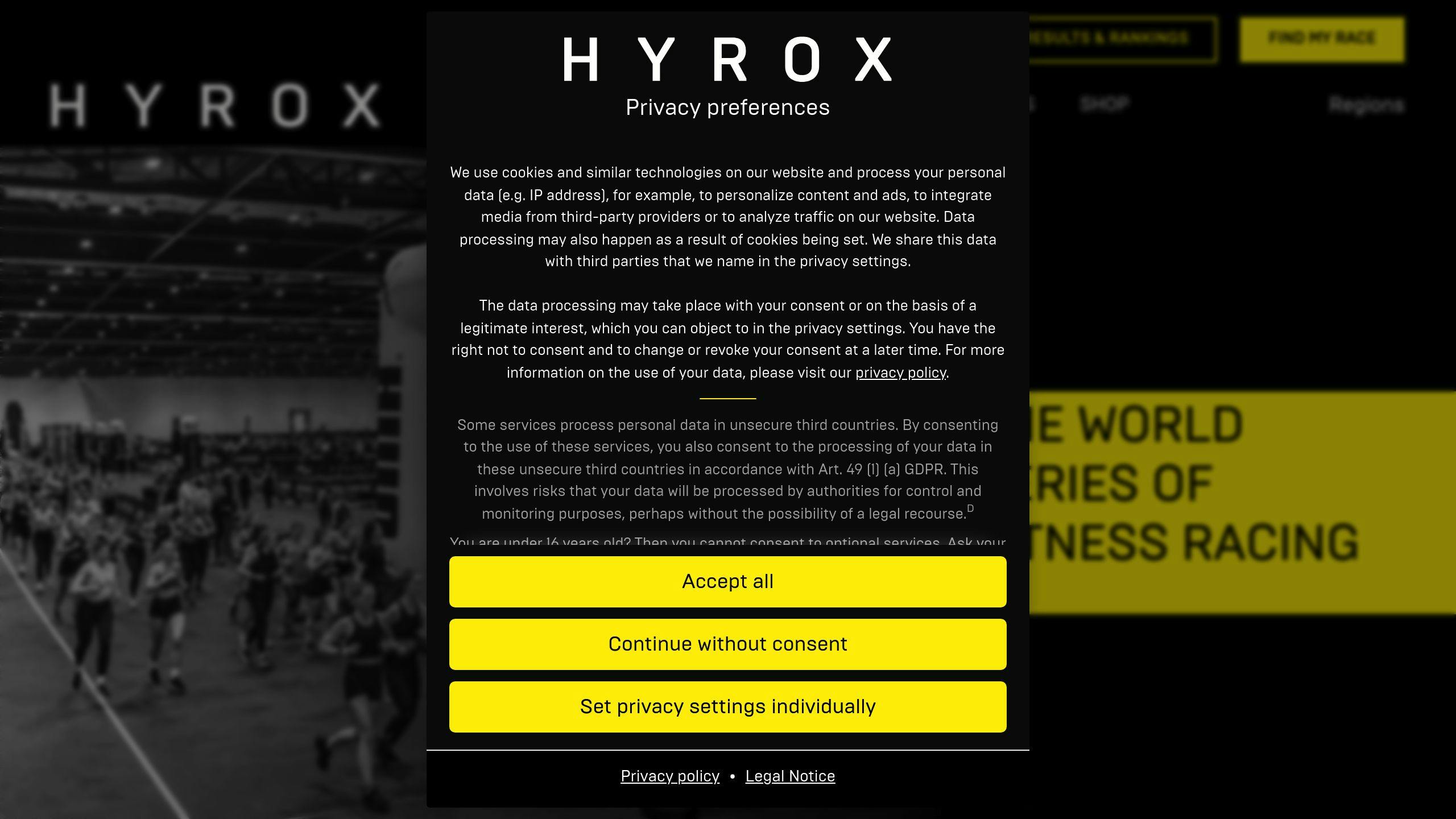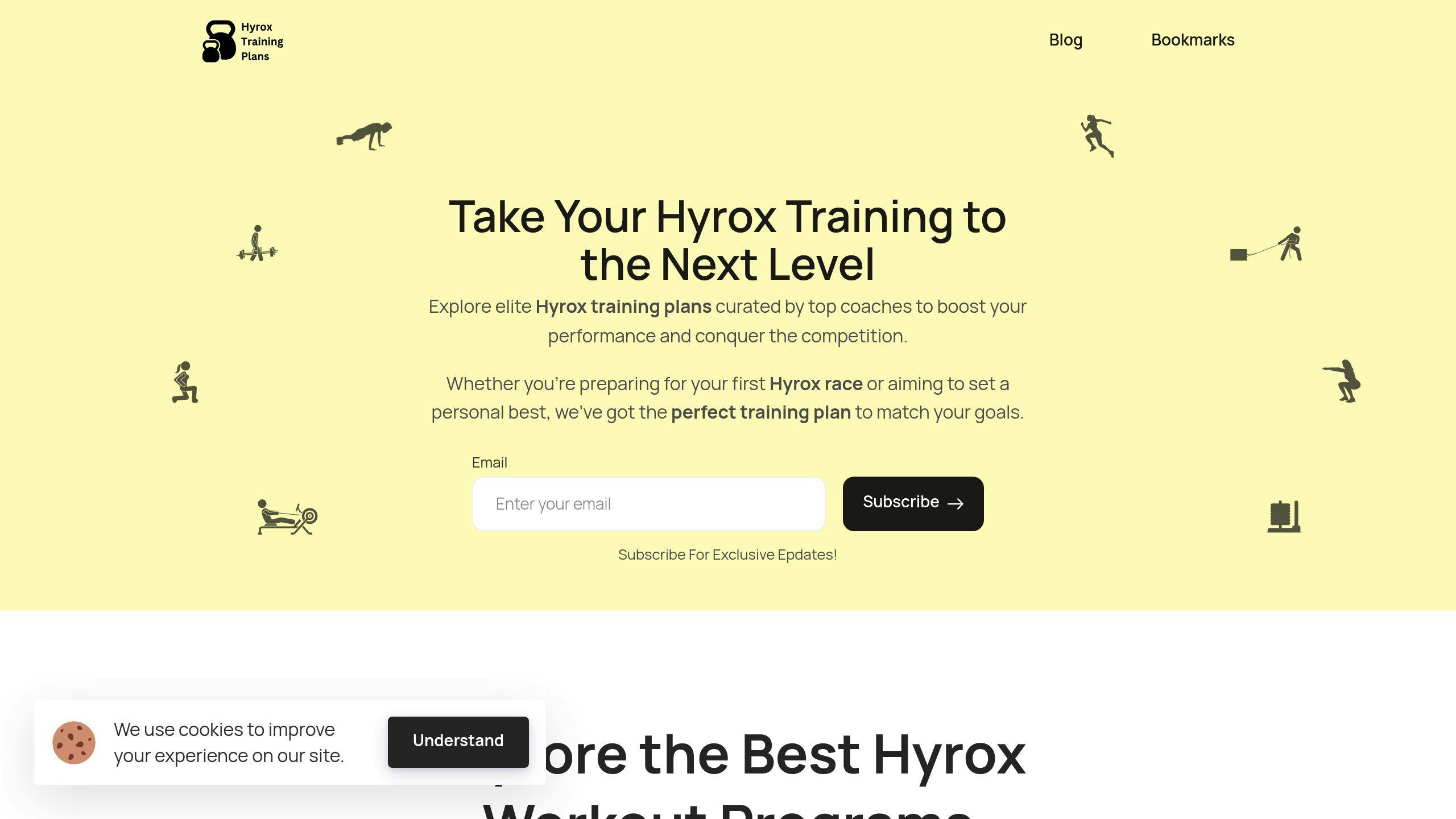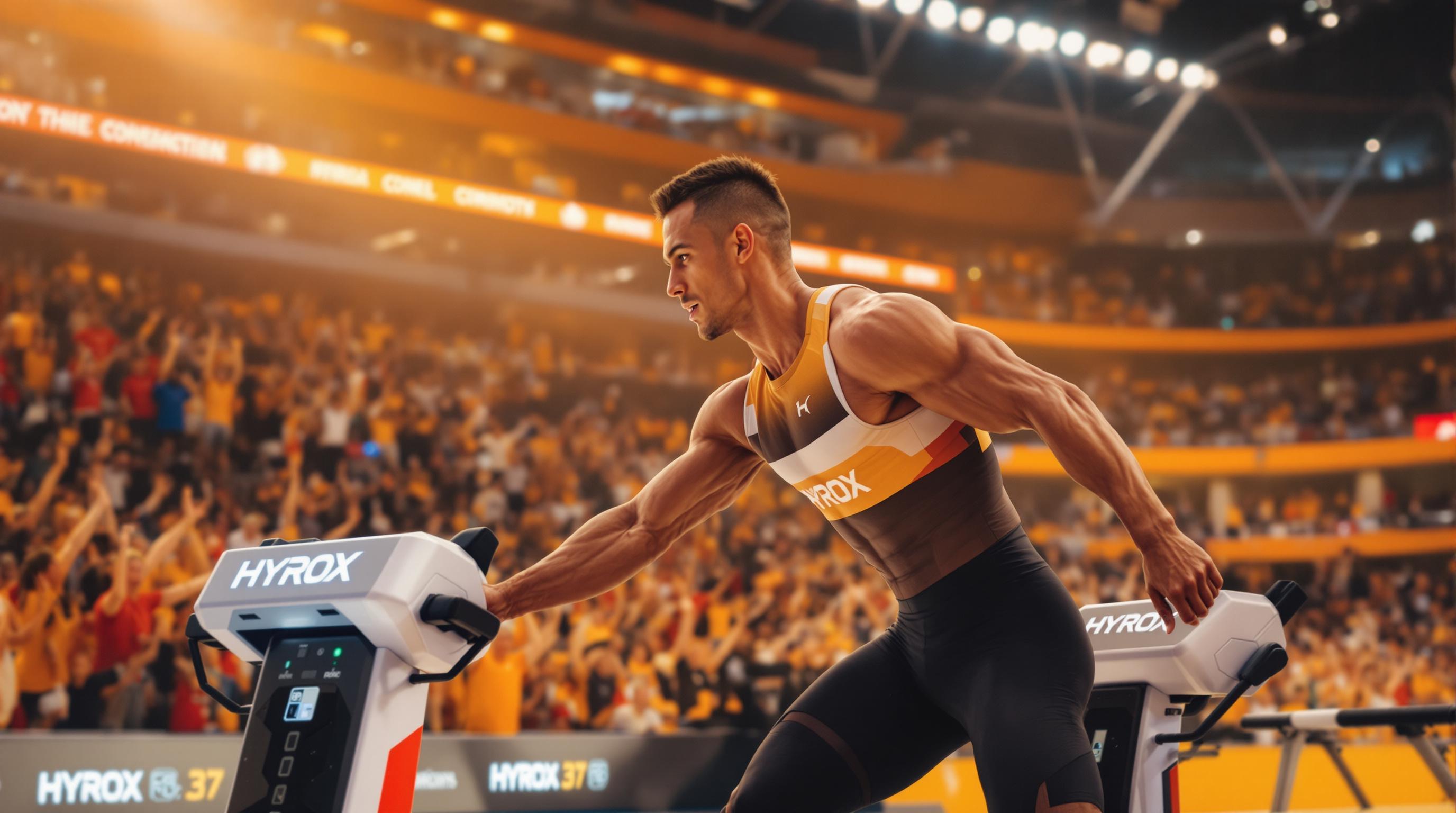Packing for a Hyrox event can directly impact your performance. Beginners focus on essentials like running shoes, snacks, and simple hydration, while pros rely on specialized gear, detailed nutrition plans, and advanced recovery tools. Here’s a quick breakdown:
- Beginners: Basics like cross-training shoes, sweat-wicking clothes, a water bottle, and simple snacks (e.g., bananas, energy bars).
- Pros: Multiple pairs of shoes, compression wear, custom hydration systems, and advanced recovery items like massage guns and compression boots.
- Nutrition: Beginners stick to familiar snacks, while pros use precise, timed supplements and fueling strategies.
- Organization: Beginners pack simply; pros use pre-sorted, station-specific systems.
Quick Comparison
| Aspect | Beginners | Pros |
|---|---|---|
| Gear | Basic running shoes, gym bag | Specialized shoes, multi-compartment bag |
| Nutrition | Energy bars, bananas | Timed carb gels, electrolyte mixes |
| Recovery | Foam roller, resistance bands | Massage gun, compression boots |
| Hydration | Water bottle | Hydration vest, custom mixes |
| Organization | Simple packing | Color-coded packing cubes |
Whether you're a beginner or a pro, smart packing ensures you're ready for race day. Keep it simple, test your gear, and adjust as you gain experience.
Gear Essentials: What Beginners and Pros Need
Beginner Gear: Focus on Basics
Starting out? Stick to the essentials. Invest in cross-training shoes that handle a variety of movements, sweat-wicking apparel to stay comfortable, and a reliable water bottle to stay hydrated. A simple gym bag will help you keep everything organized without overcomplicating things. These basics let you concentrate on your performance, not your gear.
Pro Gear: Focus on Performance
For seasoned athletes, gear becomes more specialized. Compression wear helps with muscle support and recovery, while multiple pairs of shoes - each tailored for specific race segments - become a must. Many pros also rely on recovery tools like percussion massagers and advanced biometric trackers to fine-tune their performance in real time. This level of detail reflects the same precision they apply to their nutrition and recovery routines.
Gear Comparison: Beginner vs. Pro
Here’s a quick look at how gear evolves from beginner to pro:
| Evolution Stage | Beginner Essentials | Pro Equipment |
|---|---|---|
| Footwear | Single pair all-purpose shoes | 2-3 pairs designed for specific needs |
| Clothing | Basic moisture-wicking gear | Compression wear and technical fabrics |
| Hydration | Standard water bottle | Hydration vest or belt system |
| Recovery | Basic foam roller | Massage gun, compression boots |
| Technology | Simple fitness watch | Advanced GPS and heart rate monitor |
| Storage | Basic gym bag | Specialized, multi-compartment bags |
Nutrition and Hydration Strategies
Beginner Nutrition: Simple Essentials
When starting out, stick to the basics. Use foods you've already tested during training to avoid surprises on race day.
"For beginners, the key is to keep it simple. Focus on easily digestible carbohydrates and consistent hydration. As you progress, you can start to fine-tune your nutrition strategy to match your individual needs and the demands of the event." - Sarah Thompson
Here’s a simple list to get you started:
- 2-3 energy bars you've used during training
- 1-2 bananas for a quick energy boost
- Sports drink to replenish electrolytes
- Saltine crackers for a light, digestible snack
This approach is similar to focusing on essential gear before diving into advanced options.
Pro Nutrition: Advanced Tactics
For professionals, nutrition is a science. They often collaborate with sports nutritionists to create detailed, personalized plans. Timing, portion sizes, and specific supplements are carefully calculated to enhance performance.
In a 2022 case study, one elite athlete achieved a 7-minute improvement after working with sports nutritionist Dr. Emily Carter to develop a personalized race-day nutrition plan.
| Timing | Beginner Approach | Pro Approach |
|---|---|---|
| Pre-Race (2-3 hrs) | Toast with jam | Oatmeal with protein powder |
| Pre-Race (30 min) | Half a banana | Specific carb gel with caffeine |
| During Event | Basic energy gel | Timed nutrition every 20-30 minutes |
| Post-Event | Recovery shake | Precise carb-protein ratio drink |
This shift from basic to advanced methods mirrors the progression from standard gear to specialized equipment.
Hydration: Basics and Advanced
Hydration strategies, like nutrition, evolve with experience. Beginners should prioritize steady water intake paired with simple electrolyte solutions. Pros, on the other hand, use tailored strategies to maintain balance and performance.
"Proper hydration isn't just about drinking water. Electrolyte balance is crucial, especially for pros pushing their limits." - Dr. Michael Chen, Exercise Physiologist
| Level | Hydration Essentials |
|---|---|
| Beginner | Single water bottle + basic electrolyte packets |
| Pro | Hydration vest + custom electrolyte mix + timed schedule |
Recovery and Comfort Items
Beginner Recovery: Basic Tools
If you're just starting out, stick to simple and budget-friendly recovery tools that are easy to use and effective:
| Tool | Benefit |
|---|---|
| Foam Roller | Helps with overall muscle recovery |
| Resistance Bands | Aids in mobility and stretching |
| Massage Ball | Targets specific pressure points |
| Basic Compression Socks | Improves circulation after workouts or races |
"Recovery is just as important as the workout itself. For Hyrox athletes, investing in proper recovery tools can make the difference between constant progress and burnout." - Dr. Sarah Johnson, Sports Medicine Specialist, Runner's World
Pro Recovery: Advanced Tools
For seasoned athletes, recovery often involves more advanced equipment tailored to their needs:
- Percussion massagers: Perfect for focused muscle relief.
- Compression boots: Promote better circulation and faster recovery.
- Portable cold therapy devices: Reduce inflammation on the go.
- Muscle stimulation devices: Activate and relax muscles effectively.
These advanced tools align with the natural progression in gear and nutrition as athletes gain experience.
Comfort Items: Essentials vs. Extras
Comfort items, like recovery tools, evolve with experience. While beginners and pros alike need the basics, advanced athletes usually pack extras that cater to their specific needs.
| Category | Basics | Extras for Pros |
|---|---|---|
| Clothing | Spare t-shirt, socks | Compression gear, slide sandals |
| Hygiene | Small towel, deodorant | Travel-sized hygiene kits |
| Environment | Reusable water bottle | Portable fan, cooling towels |
| Mental Prep | Standard earbuds | Noise-cancelling headphones |
As athletes advance, their choices often reflect lessons learned from past events. For example, experienced competitors might bring altitude supplements or anti-chafing solutions tailored to specific venues.
Race Day Preparation Checklist
Beginner Checklist: Simple and Clear
For first-timers, keeping it straightforward can ease pre-race nerves and ensure you’re ready for the big day. Use clear plastic bags to organize and quickly access your essentials:
| Time | Items |
|---|---|
| Pre-Race | ID, registration documents, first-aid kit |
| Race | Moisture-wicking outfit, running shoes, water bottle, 2-3 energy gels |
| Post-Race | Comfortable clothes, towel, recovery snacks |
"Focus on essentials first - you can add specialized gear later." - Anonymous Hyrox Coach
This streamlined approach aligns with the beginner-friendly gear philosophy mentioned earlier.
Pro Checklist: Detailed and Thorough
Experienced athletes take their preparation to the next level, ensuring every detail is accounted for. Hunter McIntyre, Hyrox World Champion, exemplifies this level of planning with his race day setup:
| Category | Main Items | Backup Items |
|---|---|---|
| Footwear | Running shoes, sled-specific shoes | Spare pair with extra laces |
| Clothing | Two full race outfits | Compression wear, arm sleeves |
| Hydration | Custom electrolyte mix bottles | Extra powder portions |
| Nutrition | Pre-planned gels and snacks | Emergency fuel options |
| Recovery | Foam roller, compression boots | KT tape, massage tools |
| Tech | GPS watch, heart rate monitor | - |
Packing List Comparison: Beginner vs. Pro
Statistics reveal that 78% of beginners forget at least one essential item during their first race. On the other hand, seasoned athletes follow systematic packing routines to avoid such mistakes.
| Aspect | Beginner Approach | Pro Strategy |
|---|---|---|
| Timing | Pack the night before | Multi-day staged packing system |
| Organization | Basic compartments | Color-coded packing cubes |
| Backup Items | Minimal extras | Full set of duplicates |
| Nutrition Plan | Simple timing | Segment-specific fueling plan |
| Recovery Tools | Basic recovery items | Comprehensive recovery toolkit |
"As a pro, I've learned to prepare for every scenario. My race day bag includes backup gear for each station and tools to address any potential issues that might arise." - Alex Thompson, 3-time Hyrox Elite Division Winner
Whether you're a beginner or a seasoned pro, having a solid packing strategy can make all the difference on race day.
sbb-itb-8bcd5e0
Pro Tips and Common Packing Mistakes
Tips from Experienced Athletes
"The biggest mistake I see beginners make is overpacking. You don't need five different types of energy gels. Keep it simple and stick to what you've trained with." - Lauren Weeks, Hyrox World Championship Qualifier
Top athletes often rely on a phased approach to packing:
| Phase | Action | Purpose |
|---|---|---|
| 48 hours before | Test gear | Avoid malfunctions |
| Night before | Sort by station | Ensure easy access |
| Race morning | Final checklist | Avoid forgetting essentials |
This step-by-step method works alongside detailed checklists to help avoid last-minute panic or missed items.
Common Mistakes and How to Avoid Them
"Don't underestimate the importance of post-race recovery items. A foam roller and compression socks can make a huge difference in how you feel the next day." - Michael Sandler, Hyrox Coach and Former Pro Athlete
Here are some frequent mistakes and how to avoid them:
| Mistake | Solution | Why It Matters |
|---|---|---|
| Dead devices | Set reminders to charge 12 hours ahead | Keeps tracking tools ready |
| Forgetting key gear | Pack an "essentials" bag for last-minute needs | Prevents race-day stress |
| Skipping recovery tools | Add items like foam rollers to your kit | Aids in faster recovery |
Gear Optimization for Performance
Elite athletes go beyond basic packing to fine-tune their gear for peak performance. For example, Hunter McIntyre included mid-race sock changes in his world record strategy to maintain traction - an approach now widely adopted.
Station-specific footwear is another trick many pros use, ensuring maximum efficiency for different movements. Multi-functional items like moisture-wicking buffs are also popular since they double as headbands, neck warmers, or sweat towels, cutting down on bulk without losing utility.
Conclusion: Packing for Your Hyrox Journey

Key Points
Packing for a Hyrox event changes as you gain experience. Beginners focus on basic gear and simple nutrition, while seasoned participants fine-tune their kits with specialized equipment and detailed strategies.
Here’s a breakdown of how packing priorities shift:
| Aspect | Beginner Focus | Pro Focus |
|---|---|---|
| Gear Selection | Essential basics | Gear tailored for peak performance |
| Nutrition | Easy-to-use snacks | Precision-timed supplements and formulas |
| Recovery Tools | Towel, spare clothes | Full recovery kit with advanced tools |
| Organization | Simple checklist | Station-specific organization system |
This evolution reflects the same strategic growth you’ll experience in training and recovery.
"Packing for Hyrox is about balancing preparedness with efficiency. Refine your kit as you gain experience."
Hyrox Training Plans: Your Partner in Preparation

For a well-rounded approach to Hyrox success, Hyrox Training Plans provides structured programs that combine race-day readiness with performance-focused training. Their plans include tailored gear suggestions, nutrition strategies, and recovery tips to help you perform at your best.
Hyrox Race Day Bag Essentials: Complete Kit List Guide
FAQs
Here’s a breakdown of common questions about packing for HYROX, tailored for different experience levels and concerns:
What should I pack in a bag for HYROX?
Your packing list will depend on your experience level. Here's a quick guide:
| Category | Must-Have Items | Optional Extras |
|---|---|---|
| Gear | Comfortable, broken-in running shoes; moisture-wicking clothing | Spare shoelaces |
| Nutrition | Energy bars, bananas | Sports gels, electrolyte tablets |
| Hydration | Water bottle, sports drinks | Electrolyte powder |
| Recovery | Fresh clothes, towel | Recovery drink or shake |
What do I need for HYROX race day?
Divide your gear into three phases to stay organized and ready:
Pre-Race Essentials:
- Timing chip and race bib
- Comfortable, moisture-wicking athletic wear
- Running shoes you’ve already trained in
During Race Support:
- Hydration you can access easily
- Quick snacks for energy boosts
- Small towel to manage sweat
Post-Race Recovery:
- Protein shake or recovery drink
- Basic first-aid items
Pro Tip: Use clear, resealable bags to organize your items by when you’ll need them. This simple trick, often used by experienced athletes, saves time and keeps you focused on your performance.



